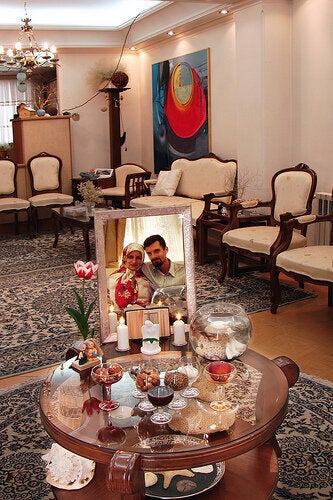
Words without Borders tells us that "50 percent of all books in translation now published worldwide are translated from English, but only six percent are translated into English." The number of adult literary books translated from non-European languages, is even significantly less. By comparison, of all the books published in Iran and countries such as the Czech Republic, Turkey and Spain, the ratio is consistently close to or more than 20 percent. Farzaneh Milani, the professor of Comparative Literature at the University of Virginia writes, "The conversation between the reading public in the United States and the rest of the world has become more like a monologue." But this one-way monologue does not apply only to books in print. Fewer Iranian artists have managed to become part of the American consciousness than would make up for the imbalance, the recent Oscar for Best Foreign Film given to A Separation -- which brings us a snapshot of Iranian society in a universal story -- notwithstanding. The multi-genre and award-winning artist, Niloufar Talebi, has consistently grafted elements of Persian poetry and philosophies into her cutting-edge projects -- which range from books to storytelling theater, to libretti for new classical music projects -- all with a goal of sparking the imagination of literary and non-literary, English-speaking and foreign-born-Iranians. In 2004, Talebi founded The Translation Project, a nonprofit arts organization that provides support for some of her projects. Since then she has created, written and performed a roster of works, including poetry-theater, videos, the bilingual anthology, BELONGING: New Poetry by Iranians Around the World (North Atlantic Books, 2008), which she edited and translated, and two libretti -- one (Ātash Sorushān [Fire Angels]) co-commissioned by Carnegie Hall, and another (Epiphany), which will have its world premiere at the Polish Biennale this year, and U.S. premiere at the Metropolitan Museum of Art in 2013. One of her recent multimedia projects -- which she wrote, created and performed in collaboration with composer and media artist, Bobak Salehi -- is the Persian Rite of Spring: the story of Nowruz. The Persian Rite of Spring, which had its world premiere at the Los Angeles County Museum of Art in 2010 as a live production, dramatizes the mythology, poetry, folklore and celebrations of Nowruz (from Yalda thru 13-Bedar, in other words, from Winter Solstice to early April) through powerful storytelling. The DVD of the performance, a high quality and gorgeous video, was released in late 2010. Nowruz, the celebration of the Spring Equinox as the New Year by some 300 million people globally, is on the UNESCO Intangible Culture of Humanity list, recognized globally on March 20th. Conjuring up a spectrum of characters, colors, and scenes, the story opens with humanity's yearnings for the birth of light during Yalda, enacts Zoroastrian fire prayers and the discovery of fire according to Persian mythology, evoking both the roots of Nowruz in ancient literature and locations such as Persepolis, the seat of the Perisan empire, as well as the modern-day practices of it in our homes. Weaving one segment seamlessly to the next, the story continues through the victory of light over dark at Equinox, leading to a dramatic conclusion completing the "cycle of the resurrection of nature." The climactic countdown to Nowruz Talebi channels on stage awakens any viewer to the moment, inevitably causing tears and goosebumps. The pitch-perfect original music, and the vibrant projected images, which she worked towards very closely with Bobak Salehi, lift and frame each step of the journey. The viewer is simply gripped from the beginning and cannot let go. Talebi's moving performance relies on her well-researched narrative, written as a pastiche of poetry from canonical literary figures of Persian literature, such as Ferdowsi, Sa'di, and Manuchehri, Iranian folktales that have been passed down to many generations, and her childhood memories of Nowruz in Iran. In her delivery, she takes oblique inspiration from Iranian spoken word traditions such as Naghaali, public storytelling of anecdotes and poetry from Ferdowsi's Shahnameh, practiced in the streets, cafes, and public rituals, blending it with her Western training in theater, a reinvention all her own. The Persian Rite of Spring is gracefully written, with poetic devices such as alliteration and assonance. Performed in English, Talebi masterfully recites Persian and Avestan sections as a tool to familiarize her audience with the rich sonic landscape of Persian poetry, as well as with the language of ancient Zoroastrian rites. Her work makes an entire culture, in which poetry is one of the most important and prized art forms, intelligible to all audiences, pulling together the pieces of a puzzle for both Iranian and non-Iranian audiences. Yearning for light is an invisible thread running through the Persian Rite of Spring, as it traces the footsteps of light in Persian celebrations. Metaphorically, yearning for light is also a recurring theme in contemporary Persian poetry, a concept that represents freedom and justice. Framing the story of Nowruz in this yearning sheds light on humanity's historical quest and struggle for harmony and peace, and showcases a culture's iconic contribution to world heritage. With this innovative and masterful, work, Talebi offers us a new form of expression, with new subject matters, perhaps a true reflection of a hybrid point of view. During times of conflict, when differences carry colossal weight and resolutions seem unforeseeable, a new form of expression from artists who create at the intersection of cultures and aesthetics will expand the realm of the possible, and bring nuances to issues otherwise viewed as black and white. The Persian Rite of Spring DVD was released in 2010, and is screening at various Nowruz events nationally. For events schedule, visit www.NiloufarTalebi.com. Artist's other projects: Four Springs (2004); Midnight Approaches (2006); ICARUS/RISE (2007); BELONGING: New Poetry by Iranians Around the World (2008); Ātash Sorushān (Fire Angels) (2011); Epiphany: A Requiem Mass (2012) References: 1. Jascha Hoffman, "Data: Comparative Literature," New York Times Book Review, Apr. 12, 2007.2. Milani, Farzaneh. Words Not Swords. Syracuse University Press, 2011. Pg. 227.